TheRoundup is reader supported. We may earn a small commission when you make a purchase via links on this site, at no cost to you.
All products are personally reviewed and tested in accordance with our Review Methodology.

I love how a swipe of good lipstick can transform my mood and uplift any outfit.
However, did you know that in 2010, the FDA found lead in almost every brand of lipstick it tested?
And then there are all the other nasties, such as parabens, phthalates, synthetic fragrances, microplastics, and more. None of which should be sat on your lips all day.
The solution is non-toxic lipstick. But with so many brands claiming to be green, eco-friendly, and sustainable, how do you know who to trust?
I've combined my love of lippy with my tenacious (some would say obsessive!) approach to testing and research to unearth the best brands offering clean and natural lipstick in 2024.

✔ Versatile (Eyes, Lips, and Cheeks)
✔ Natural Ingredients
✔ Vegan, Cruelty-Free, & Palm Oil-Free
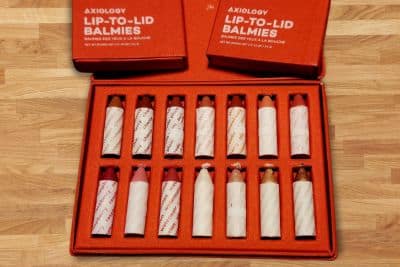
Why It's My #1 Pick: I love Axiology's eco-credentials and the fact the company is BIPOC-owned and woman-run.
Also, as someone who prefers an uncomplicated yet effective beauty routine, it's great to have a single product for my eyes, lips, and cheeks.
The Super Fan Pack I tested includes 14 shades suitable for any occasion. It's become my go-to choice for everyday wear and special events.
Personal Experience: The Axiology Super Fan Pack has simplified my makeup routine and made it more environmentally friendly.
Each crayon (Axiology calls them 'Balmies') in the pack glides smoothly and has a satisfyingly creamy texture. This is a big difference from the drying, cakey feel of some of the poorer-quality lipsticks I tested and dismissed.
Axiology makes its Balmies with just nine natural ingredients. I find that the matte finish and rich pigmentation look vibrant on my skin and lips and make my skin look and feel healthier.
I love how this one product has allowed me to declutter my makeup bag dramatically. Now I carry just one or two sticks that cover all bases.
I also really like the recyclable paper packaging, which doubles as a carrying case.
About the Brand: Founded by Ericka, Axiology shows what one person's passion can achieve. The brand uses completely plastic-free materials derived from recycled island trash. This helps reduce landfill waste and provides stable, fair-paying jobs to women in Bali!

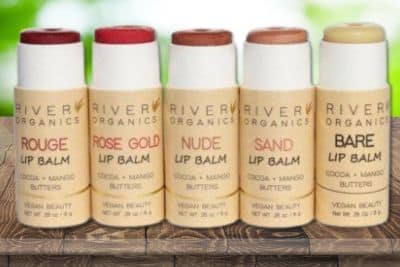
Why It's the Best Lip Stain: The Fig Vegan Lip Stain from River Organics beat all the other stains I tested because of its incredible hydration levels.
The use of restorative Shea butter and moisturizing plum and jojoba oils provided a nourishing experience that most others struggled to achieve.
Personal Experience: I very much enjoyed using this lip stain during testing. The rich shade provided just the right amount of color to enhance my natural look without overpowering it.
I was surprised (in a good way) by the texture of this product. It's surprisingly creamy for a stain, gliding on smoothly without the drag typical in other long-lasting products.
However, what truly set it apart during testing was how it felt on my lips. There was none of the typical dryness associated with stains. Instead, my lips felt continuously moisturized thanks to the nourishing oils and butters in the formulation.
About the Brand: Based in Wilmington, NC, this independent company was founded by an art historian and a former chemist for Chanel's skincare labs.
River Organics commits to 100% vegan ingredients, transparency in formulation, and a strict zero-waste philosophy.
All its organic lipstick products are encased in fully compostable paper tubes and shipped in recycled materials.
Or Buy on Amazon (Without Discount)

✔ Non-Sticky & Hydrating
✔ Sensitive Skin Safe
✔ Sustainably Packaged
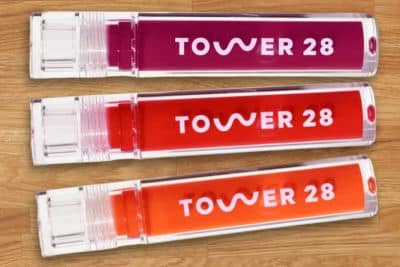
Why It's the Best Lip Jelly: Tower 28's ShineOn Lip Jelly very much shone during testing (pardon the pun). Most of its competitors left my lips feeling sticky. But this lip jelly quickly dried to a lovely, moisturizing, glossy finish.
I also liked that its sensitivity-safe assurance means it can be used by virtually anyone, regardless of skin type, without fear of irritation.
Personal Experience: I'm not normally a lip gloss/jelly kind of gal, so I didn't know what to expect while testing this type of lip product.
Most lip glosses provide temporary shine without much thought for lip health. However, ShineOn Lip Jelly is formulated to moisturize and protect, something I really noticed working during testing.
Wearing it throughout the day, I noticed a significant improvement in the condition of my lips (making them more supple and less prone to chapping). I also found that the subtle touch of color (I tested Semi-Sheer Raspberry) was perfect for daily wear, enhancing my natural lip color rather than overpowering it.
The list of ingredients is longer than I would generally approve of. However, knowing that this lip jelly had passed the Credo Clean Standard gives me peace of mind that it's a non-toxic product.
About the Brand: Tower 28 Beauty is inspired by the carefree vibe of Santa Monica's lifeguard Tower 28 (a hub for community and healthy fun).
Founded by Amy Liu, a veteran in the beauty industry with sensitive skin, the brand is committed to creating products that are safe, non-irritating, playful, and accessible.
All Tower 28 products are rigorously dermatologist and allergy-tested, ensuring they meet the highest safety and performance standards. This commitment also extends to their packaging, which uses at least 50% post-consumer resin (PCR).

✔ 87% Organic
✔ Recyclable Aluminum Tubes
✔ Supports Local Manufacturing
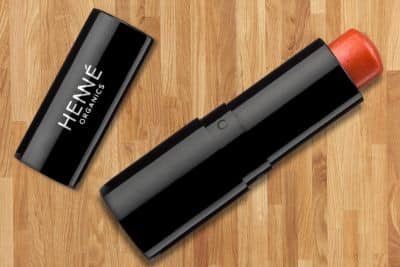
Why It's the Best Organic Luxury Option: Unlike many of the other lip tints I tested that claim to be organic but compromise on performance, Henné Organics delivered on both fronts.
Due to its superior blend of nourishing ingredients and ethical manufacturing, the Luxury Lip Tint I tested felt exactly that...luxurious!
It's made with high-quality, organic ingredients such as coconut oil, jojoba oil, and vitamin E. This provided exceptional hydration and kept my lips soft all day.
Personal Experience: I loved the coral shade I tested. It's flattering for a wide range of skin tones, providing just the right amount of warmth to enhance natural beauty without overwhelming it.
The texture was luxuriously creamy and smooth, which made applying it easy. From the first swipe, this lip tint provided a burst of hydration and a pop of color (both of which I found to be very long-lasting).
I also liked the aluminum tube packaging. It felt luxurious and was fully recyclable.
About the Brand: Henné Organics merges impeccable Scandinavian design with high-performance, eco-friendly ingredients.
Laura Xiao created the brand to bring a touch of everyday luxury to the organic beauty market without compromising on aesthetics or ethical standards.
Operating from Wilmington, North Carolina, Henné Organics is USDA Certified Organic and Cruelty-Free certified by Leaping Bunny.

✔ Free from Parabens, Talc, Synthetic Dyes, and Fragrances
✔ Encourages Creative Play
✔ Enriched with Organic Coconut Oil
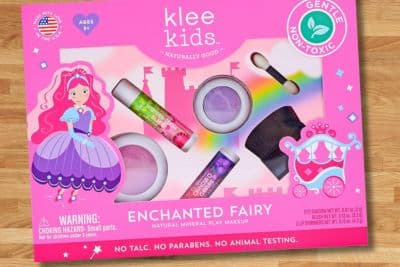
Why It's the Best Lipstick for Kids: Adult makeup (even non-toxic options) is too harsh for the skin of young children. Klee Naturals' products are designed to be gentle on young, sensitive skin.
I love the use of organic oils and the absence of harsh chemicals such as parabens and synthetic fragrances. This makes Klee Naturals ideal for children eager to experiment with makeup.
Personal Experience: I don't have children. However, I'm a proud Aunt and love spoiling my niece, Bella. She was delighted to test the Enchanted Fairy Makeup Up Set for me.
She particularly loved the Watermelon Slice lip shimmer, which gave just a hint of color and sparkle without being overwhelming.
As we applied the makeup together, I was impressed by how the products were formulated to be gentle yet effective. The lip shimmer provided enough color to make Bella feel grown-up while giving me peace of mind that it washes off easily and is free from harmful chemicals.
About the Brand: Founded on the principle of safe, natural play, Klee Naturals uses only natural, non-toxic ingredients in their formulations.
The lip products I tested had to excel in the following categories to make it into this article and onto my list of personal recommendations.
The ingredients were my starting point for every test.
I rejected any lipsticks with long lists of ingredients I couldn't pronounce.
I'll cover which ingredients to avoid and prioritize later in this article.
How lipstick feels on your lips is also very important.
I tested each lipstick in multiple scenarios to ensure it didn't leave my lips dry or cakey.
Non-toxic lipstick isn't just about being safe; it must also look good.
I tested a range of shades to see how the colors perform across different skin tones.
It's important to me that my recommendations are as diverse and vibrant as the ecosystems we're trying to protect.
I tested for any strong or unpleasant odors that might be off-putting.
If the lipstick was scented, I checked to ensure the smell was derived from natural sources and not overpowering.
Whether it's a day at the beach or a coffee date with my gym crush, I need to know these lipsticks can last.
I checked how well they held up after eating, drinking, exercising, and the occasional wipe.
I examined how the lipstick performed under various conditions, such as different climates or occasions (smart, casual, etc.).
Bonus points were awarded for multiple uses (for example, if it can double as a cheek tint).
I prioritized testing lipsticks carrying certification marks.
Certifications tell me that the product meets stringent environmental and ethical standards.
More on exactly which ones to look out for in a later section.
The carbon footprint of getting the product to your door matters. So, I looked at the company's shipping practices for each lipstick.
Are they using recycled materials? Is the shipping carbon-neutral? These are essential questions.
Some of the potentially harmful ingredients found in traditional lipsticks include the following.
If you already own some lipsticks, or want to verify that your favorite brand is non-toxic before continuing to buy from them, then this is what you need to look for:
Buying products that carry well-known and trusted third-party certifications can help you avoid cosmetic industry greenwashing.
Some of the best certifications to look out for include the following:
When scanning a lipstick label, ingredients are listed in order of concentration.
Keep an eye out for long, unpronounceable words, which are often the ones to avoid.
Stick to labels with ingredients that sound more like a recipe and less like a chemistry experiment.
According to a 2010 FDA analysis of 400 lipsticks, the two brands with the highest lead content were Maybelline and L'Oréal.
Lead levels in most modern-day lipsticks (especially the ones recommended in this article) are at an all-time low.
However, you should remain vigilant and use non-toxic products wherever possible. The FDA has some good further information on lead in cosmetics.
All of the recommendations in this article are safe for daily use.
It's clear that choosing the right lipstick can impact both our health (reducing exposure to chemicals) and the planet (reducing plastic waste).
Each recommended brand, from Axiology's versatile Super Fan Pack (my #1 pick) to Klee Naturals' kid-friendly formulas, shows you can have beauty without compromising health and sustainability.
I've rigorously tested and researched these products to ensure they meet the highest safety and performance standards. By choosing these non-toxic options, you're not just beautifying your routine; you're committing to kinder and safer products.
Want even more beauty recommendations? Check out James' guide to non-toxic makeup brands.

Our core values mean we always prioritize sustainability over profit. We carefully evaluate and personally test every product to ensure they meet our high standards. All products recommended in this article were tested in accordance with our Review Methodology.
TheRoundup.org - As Seen On
